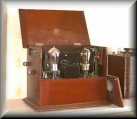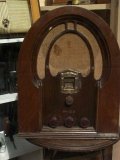Filmic - styles of radio drama directing and post-production which creatively relate to film
USING FILM TERMS IN PRODUCTION
| Many radio drama directors use film + TV production terms when working with actors, talking about 'shots' for example. This makes a lot of sense in constructing sound pictures. It is a common language and it is a creative shorthand. |
| EXAMPLES: CU or 'close shot', medium close up shot or MCU, and medium shot or MS, to the 'knees'. (These are microphone positions 2 and 3 - Beck, Radio Acting, 48-56.) There is also further off (LS 'long shot' - microphone positions 4 and 5). |
| See Perspective |
Key terms: close-up shot (CU)
close-medium shot (CMS)
medium close up shot (MCU)
medium shot (MS)
medium long shot (MLS)
long shot - far distance (LS)
very long shot (VLS)
MORE FILMIC TECHNIQUES FOR RADIO DRAMA DIRECTING STYLE
| TRACKING 'SHOT' TECHNIQUE - like the lengthy 'mise en scène' camera shot - see technique - 'moving camera' or 'we go with' or 'mise en scène' 'shot' |
| Moving sound centre technique - 'we go with' - see SOUND CENTRE |
| This works best in the radio drama split-realism scene: the realist 'mise en scène' is tracked by the moving sound centre, while balanced with this is an internal monologue (the protagonist fully describes plot events and the location being moved through). |
| Use montage - cross-faded 'segments' + music (underscoring) |
| Look for genre plot situations where montage best works - see Types of plays |
| An example is '24' - see the BBC OFFICIAL SITE at http://www.bbc.co.uk/cult/24/ |
| '24' makes such distinctive use of underscoring music, split screen, and exciting plot events within the thriller genre. |

USE FILM PRODUCTION AND POST-PRODUCTION SYSTEMS
- SUCH AS Storyboard - different types and how to make it work for you
USE FILM VARIETIES OF SCENE BOUNDARIES
| SCENE BOUNDARIES - and - scene boundaries - more |
| Combine the overall rhythm of the play with genre and music. |
FILMIC SYSTEM OVERALL
| I prefer the FILMIC SYSTEM OVERALL - working mostly in post-production, and reducing the amount of SPOT EFFECTS in Studio production. |
| You need a large archive of digital sound effects - see SOUND BOX - production sound effects archive |
| This causes you to rethink how you work with the actors and in the Studio. You need less from them. |
| You can fill in and reshape and be creative with pre-recorded sound effects for 'presence', movement and 'being in', and embodying, as well as Spot Effects. |

If for broadcast, you probably should respect BBC Editorial Guidelines

|
|


